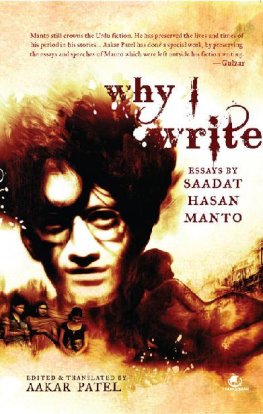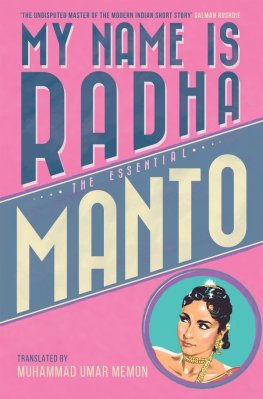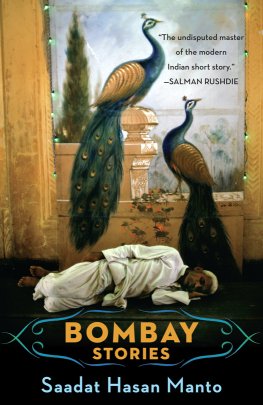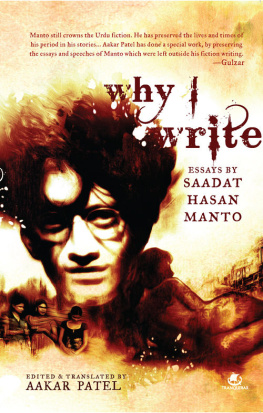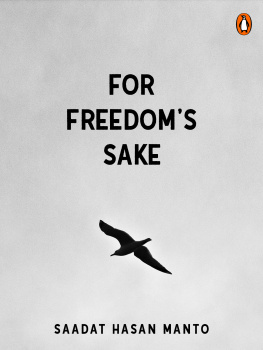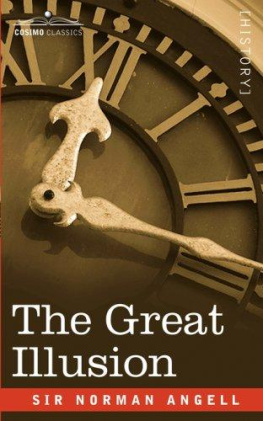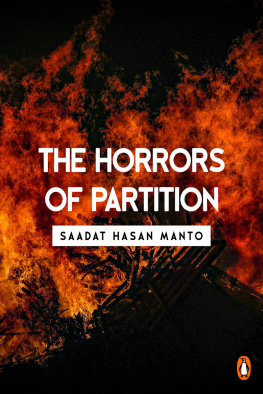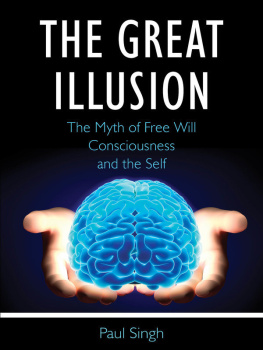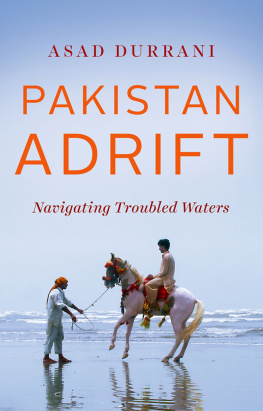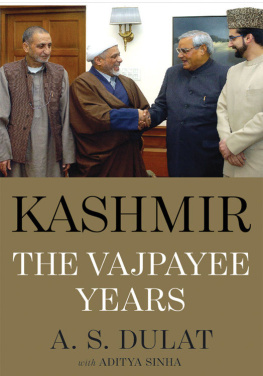Previously by A.S. Dulat and Aditya Sinha
Kashmir: The Vajpayee Years (2015)
Previously by Aditya Sinha
The CEO Who Lost His Head (2017)
Death of Dreams: A Terrorists Tale (2000)
Farooq Abdullah: Kashmirs Prodigal Son (1996)
Forthcoming from Asad Durrani
Pakistan Adrift: Navigating Troubled Waters (2018)
THE SPY
CHRONICLES
RAW, ISI and the
Illusion of Peace
A.S. Dulat, Asad Durrani
and Aditya Sinha

To my late parents, Shamsher and Raj, who spent many joyous hours playing bridge with two successive High Commissioners of Pakistan in India: Syed Fida Hussain, my fathers former ICS colleague, and Abdul Sattar.
A.S. Dulat
To all the faceless agents who take great risks in the service of their country.
Asad Durrani
To my parents, Neelam and Chandreshwar Narain Sinha, who, in England during 1965-71, were best friends with Gulshan and Nazir Hussain, immigrants from Lahore.
Aditya Sinha
Contents
If only somehow you could have been mine,
what would not have been possible in the world?
Agha Shahid Ali, The Country
without a Post Office

In the dedication, A.S. Dulat and I have each mentioned India-Pakistan friendships that were deep and, silly as it may sound, beautiful. It is a growing fear that in the age of shouting heads on TV and hyper-nationalistic NRIs, we are reminiscing about a bygone era. All hope is not lostmy elder daughter was best friends with a Karachi-ite during her undergraduate years at New York University. On the whole, however, she seems part of a shrinking minority, and a window of opportunity for goodwill between the people of the two nations may be closing. It is to keep that window open, and show that through the window one may see endless possibilities, that this book was written.
The hostilities that are ceasefire violations across the Line of Control erupt occasionally, but the norm is of long periods of peace. Similarly, armed conflict between India and Pakistan has broken out on four occasions in their 71 years of independence. Even the proxy war of terrorism is characterised by intense bursts of violence that occasionally puncture everyday peace.
The cold war between nations, conducted by their spy agencies, is continuous, however. There is no let-up. There are no uniforms, or counter-measures that force terrorists to opt for soft targets. Spies and their networks live 24x7 lies at great risk to themselves. They are a last line of defence. If a Kargil happens, then it is ultimately attributed to intelligence failure. Terrorism is seen as a slippage through an invisible net put up by the agencies. War is either pursued or averted mainly due to intelligence efforts.
The armys Inter-Services Intelligence (ISI) directorate has been Pakistans main intelligence agency since immediately after independence. The cabinet secretariats Research and Analysis Wing (RAW), founded 50 years ago as of September 2018, was created out of Indias Intelligence Bureau (IB) due to perceived failures of the 1962 and 1965 wars with China and Pakistan, respectively. Due to Pakistans unique history, the ISI has gained a larger-than-life aura, often seen in India as Pakistans Deep State. The RAW has a similarly sinister image, if not among its own citizens then at least among those across the western border.
This book brings together two men who each had a stint at heading their respective agencies. As such, they have been privy to their nations greatest secretswhether they relate to secret agents placed in sensitive foreign locations, nuclear weaponry, strategic intelligence, or secret liaison with foreign agencies and governments. They are the keepers of their nations dark matter.
Indians and Pakistanis keep trying to talk to one another. Politicians and diplomats speak to their counterparts; peaceniks exchange notes; sportsmen share locker-room chat; and businessmen drool over each others markets. This is open. Spychiefs rarely talk to each otheryou can be certain that the spies never dothough there have been occasions when their governments have directed them to do so. In the last two decades, some former spychiefs have come together to exchange views in Track-II dialogues. But they have never spoken openly.
As the two spymasters say, they are aware of the stakes. What they say to each other, around a table, their guards down, counts for something. Their conversation goes to the heart of the India-Pakistan relationship; a deep dive into the Deep State, if you will.
This book was Dulats suggestion after the encouraging success of the 2015 book we co-wrote, Kashmir: The Vajpayee Years. Since he and Durrani had earlier co-authored two papers, his idea was to follow that format. Chiki Sarkar, the publisher at Juggernaut Books, suggested to me that to reach a wider audience as well as to make it an interesting read, it ought to be in a dialogue format. She pulled Hitchcock/Truffaut out of her living room library as an example. It was a winning suggestion, in my opinion.
After Dulat got Durrani on board, they enlisted the help of Peter Jones, of the University of Ottawas Centre for International Policy Studies. He helms the Track-II Intel Dialogue between India and Pakistan, and he graciously agreed to host me at the meetings in Istanbul (May 24-26, 2016) and Bangkok (February 1-3, 2017 and October 28-30, 2017), so that we could spend a couple of days after the official engagement to produce material for this book. There was a meeting that we did on our own in Kathmandu, Nepal (March 25-29, 2017), though Sudheendra Kulkarni of the Observer Research Foundation, an ardent supporter of the project throughout, offered to facilitate.
These meetings produced a total of over 1.7 lakh words. The manuscript prepared for publication was half that size. The transcripts had a lot of spontaneity and the two former chiefs got into the spirit of each discussion; I have tried to retain that tone in the manuscript, despite the second thoughts of each participant at different points. I have also attempted to provide the flowing literary style that Dr Farooq Abdullah told me he admired most about Kashmir: The Vajpayee Years.
Unlike Kashmir: The Vajpayee Years, which was essentially Dulats narrative and thus demanded to be read chronologically, this conversation between Dulat, Durrani and myself can also be read differently: that is, one may read chapters or sections out of order or in isolation, and drift back and forth through the book as one fancies. The choice is the readers.
In acknowledgement, mention must go to Krishan Chopra, who seized the project with both hands and did not let go; Siddhesh Inamdar, who put in much effort to produce this book; my friends Mayank Tewari, who at difficult moments reminded me that Philip Roth would have treated this project as material, V. Sudarshan, who reminded me that this project was an enviable journalistic exercise, and P. Krishnakumar, who gave me a gig at Mid-Day which was invaluable in more ways than one; and of course my spouse, Bonita Baruah, whom I regard as my better 51 per cent.
Aditya Sinha
New Delhi, India
March 2018

Pointing to the horizon where the sea and sky are joined, he says, It is only an illusion because they cant really meet, but isnt it beautiful, this union which isnt really there.
Saadat Hasan Manto
Kaash ke hum dost hote.
General Asad Durrani and I have gelled ever since we met at a Track-II dialogue named after Thailands Chao Phraya River. It was held in the aftermath of 26/11, in the wake of Western apprehension of what may come to pass. Who knows, if a madman was in control we could all still be blown to kingdom come, in revenge for 1971 or even 1947.
Next page

